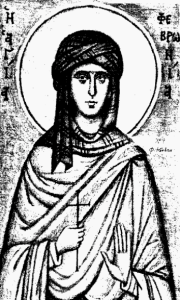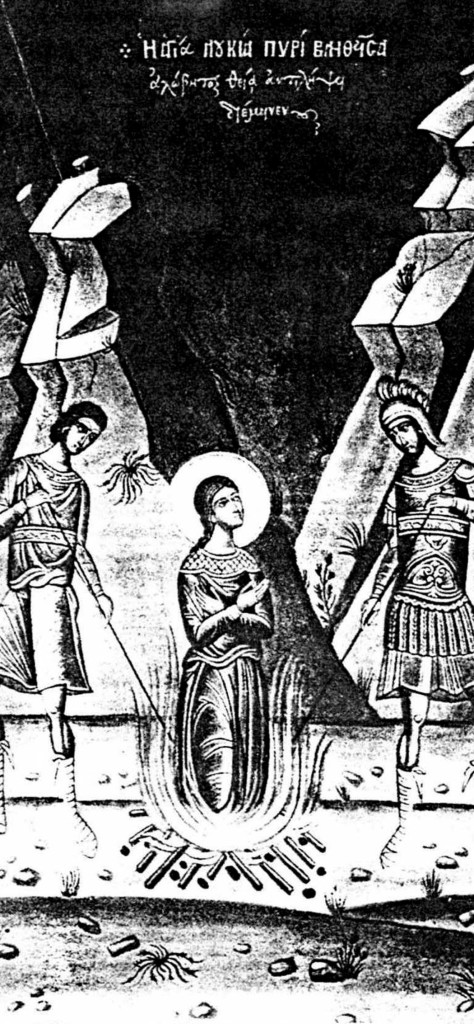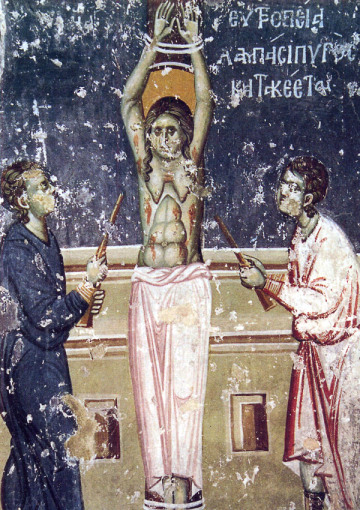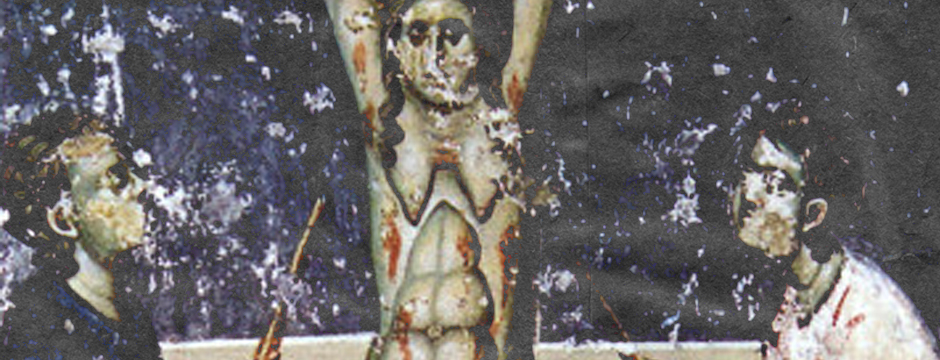 The following is a true account of a woman who gave her life for the sake of truth and for God. On the 25th of June in the year 305 AD this woman suffered the greatest torture ever imaginable and this we warn the reader that what they are about to experience might be shocking or upsetting. Please understand that those who love the truth don’t fear what people will do to their flesh for their faith. After reading this account one cannot help but understand and feel that in truth there is a living and loving soul within our flesh that desires freedom, a freedom that only God can give.
The following is a true account of a woman who gave her life for the sake of truth and for God. On the 25th of June in the year 305 AD this woman suffered the greatest torture ever imaginable and this we warn the reader that what they are about to experience might be shocking or upsetting. Please understand that those who love the truth don’t fear what people will do to their flesh for their faith. After reading this account one cannot help but understand and feel that in truth there is a living and loving soul within our flesh that desires freedom, a freedom that only God can give.
The Virgin Martyr Febronia suffered during the reign of Diocletian (284-305). She was raised at a monastery in the city of Sivapolis (Assyria). The head of the women’s monastery was the abbess Bryaena, the aunt of St Febronia. Being concerned about her niece’s salvation, she assigned her a stricter form of life than the other nuns. According to their monastic rule, on Fridays the sisters put aside their other duties and spent the whole day in prayer and the reading of Holy Scripture. The abbess usually assigned the reading to St Febronia.
News of her pious life spread throughout the city. The illustrious young widow Hieria, a pagan, began to visit her, and under the influence of her guidance and prayer she accepted holy Baptism, bringing her parents and kinsfolk to the Christian Faith.
Diocletian sent a detachment of soldiers to Assyria under the command of Lysimachus, Selinus and Primus for the destruction of Christians. Selenos, the uncle of Lysimachus, was noted for his fierce attitude against Christians, but Lysimachus was of a different frame of mind from him, since his mother had sought to inspire love for the Christian faith in her son, and she had died a Christian. Lysimachus had discussed with his kinsman Primus how it would be possible to deliver Christians from the hands of the torturer. When the detachment of soldiers approached the convent, its inhabitants hid. There remained only the abbess Bryaena, her helper Thomais and St Febronia, who was seriously ill at the time.
It grieved the abbess terribly that her niece might fall into the hands of the torturers, who might defile her. She prayed fervently that the Lord would preserve her and strengthen her in the confession of Christ the Savior. Selinus gave orders to bring him all the nuns of the convent. Primus with the detachment of soldiers found no one, except the two old women and St Febronia. He regretted that they had not hidden, and he suggested to the nuns that they flee. But the nuns decided not to leave the place of their labors and they entrusted themselves to the will of the Lord.
Primus told Lysimachus about the particular beauty of St Febronia and advised him to take her for himself. Lysimachus said that he would not seduce a virgin dedicated to God, and he asked Primus to hide the other nuns somewhere so that they would not fall into the hands of Selinus. One of the soldiers overheard the conversation and told Selinus.
The emperor was informed of the existence of a women’s monastery and forthwith soldiers were dispatched to arrest and bring before the judgment seat all the nuns. Breaking down the door with hatchets, one of the soldiers then wielded his sword to strike down the Abbess. A young nun by the name of Fevronia falling at his feet said, “I beg you before God who dwells in the heavens, slay me first, so I may not witness the death of my friend.”
The soldiers like wild beasts went and seized Fevronia and clapped a heavy iron collar around her neck, and began pushing her about. The soldiers then took Fevronia, ushering her out of the convent.
 A great multitude assembled in the amphitheater when the saint with an iron collar and hands tied, was brought forward. Everyone in the crowd was moved to compassion. The persecutor then spoke to Fevronia, saying, “Maiden, what are you, slave or freeborn?” Fevronia answered, “Slave.””Whose slave are you?”
“I am the servant of the Lord.”
He then asked, “What is your name?”
She answered, “The poor Christian woman.”
A great multitude assembled in the amphitheater when the saint with an iron collar and hands tied, was brought forward. Everyone in the crowd was moved to compassion. The persecutor then spoke to Fevronia, saying, “Maiden, what are you, slave or freeborn?” Fevronia answered, “Slave.””Whose slave are you?”
“I am the servant of the Lord.”
He then asked, “What is your name?”
She answered, “The poor Christian woman.”
He then began to try to convince her to marry a man who desired her beauty, but Fevronia answered, “I Have an indissoluble bridal chamber in the heavens that is not made by hands, and a dowry which is the Kingdom of the heaves, and a deathless Bridegroom. Therefore it is not possible to live with a man. Do not be deceived; neither labor to test me with flatteries and Threats, for you will never defeat me.”
Upon hearing this challenge the tyrant flew into a rage. He ordered that the holy woman be disrobed and displayed before all, so that she might be shamed by her indecent exposure. After the soldiers removed her monastic garb and presented her naked, the perverse tyrant said, “Do you see, Fevronia, what things you could have had and have given up?”
Fevronia, a very pure person in body and soul answered, “There is but one Creator Who, in the beginning, made us male and female. Wherefore, I am not only willing to endure this nakedness, but to have each of my limbs dismembered for my Christ if he gives me His Grace to suffer torments for His Love. Therefore I must tolerate this nakedness that I might contest with the devil, your father.”
Moved to wrath again, the persecutor ordered that four men stretch and bind the nun so that they could mercilessly beat her back. The pitiless men beat her for a long time, whilst others made a fire under her and sprinkled the fire with oil, causing her worse burns. Witnessing this atrocious punishment the crowd cried aloud, “Have compassion on the young woman!”
On The contrary he ordered his men to increase the scourging and beating. When it was seen that the strips of her flesh fell to the ground and that she appeared dead, he commanded that she be cast to one side. Seeing her move he said aloud, “How did the first match seem to you, Fevronia?” Christ’s martyr answered, “Know that in the first trial with Christ helping me, I not only remained unconquerable, but I regarded your tortures with contempt.”
The prosecutor then said, “Suspend her upon the wooden pole and lacerate her sides with iron claws; then burn her torn members to the bones.” They tore at the saint so that her flesh fell to the ground and her blood streamed forth as a river. Later they brought fire and burned her entrails. Looking steadfastly up into heaven she said, “Come to my aid, O Lords, and do not abandon your servant.”
Many of the spectators left, unable to bear the persecutors raw pitilessness. She was then taken down and tied to a stake. He continued to try and interrogate her but she wasn’t able to answer. Because of this he ordered a physician to cut and remove her tongue and burn it. Hearing this, the saint immediately extended her tongue, nodding to the physician to cut it off. When the physician removed his iron surgical instrument, the crowd asked the persecutor to let her be left alone for a while. The savage man agreed to leave her tongue in place; but ordered instead the breaking of her teeth, which the physician began to do. From the pain and hemorrhaging Fevronia fell unconscious.
Upon her coming to, the persecutor asked her, “What do you say Fevronia? Will you worship the gods?” The holy woman answered, “You are an accursed old man! Why do you not slay me quicker that I may go to my beloved Christ, instead of impeding my path?”
Then he commanded that her breasts be cut off so her chest might be further burned. When her right breast was cut off and thrown to the group, the saint prayed, “O Lord, my God, behold my affliction and let my soul come into your hands.” After the removal of her left breast, she fell silent as all those who witness this spectacle cursed the persecutor and his gods.
He then had her removed from the stake, and unable to stand she fell to the earth. He then ordered the severing of both her hands and one foot. Her want was then cut off. When the executioner attempted to remove her foot, the axe missed the joint of the ankle bone. Only after three swings was he able to remove her foot. Fevronia experiencing incredible pain then extended her other foot upon the wooden block so that he might be able to remove the other foot also.
 The persecutor upon seeing this became ever more hardened and said, “Do you see the strength of this shameless woman?” When Fevronia’s other foot was dismembered, the evil ones said to one another, “Let us go and eat and leave this ill-fated one, since you have punished her enough.” The persecutor then answered, “By the gods, I am not leaving until she gives up the ghost!” Her head was then struck off, and she left this heartless and painful world, and entered into eternal life through her glorious death.
The persecutor upon seeing this became ever more hardened and said, “Do you see the strength of this shameless woman?” When Fevronia’s other foot was dismembered, the evil ones said to one another, “Let us go and eat and leave this ill-fated one, since you have punished her enough.” The persecutor then answered, “By the gods, I am not leaving until she gives up the ghost!” Her head was then struck off, and she left this heartless and painful world, and entered into eternal life through her glorious death.
Among the crowd was the nun Thomais, who afterwards recorded St Febronia’s martyrdom in detail, and also her student Hieria. She came forth out of the crowd and in the hearing of all reproached Selinus for his boundless cruelty. He gave orders to arrest her, but learning that Hieria was of illustrious standing whom he could not readily subject to torture, he said, “By your speech you have brought on Febronia even greater torment.” Finally, they beheaded the holy Martyr Febronia.
Departing the place of execution, Lysimachus wept and withdrew to his quarters. Selinus made ready to eat, but he was not able to take food, and went off to the quiet of his own chambers. Suddenly, he became like one deranged. Looking up to the heavens, he raved and bellowed like a bull, then fell down and struck his head on a marble column and died. When Lysimachus learned of this, he said, “Great is the God of the Christians, Who has avenged Febronia’s blood, so unrighteously shed!” He prepared a coffin, placed the martyr’s body in it, and took it to the convent.
Abbess Bryaena fell senseless, seeing the mutilated remains of St Febronia. Later, she recovered her senses and gave orders to open the convent gates so that all would be able to come and venerate the holy martyr and glorify God Who had given her such endurance in suffering for Christ. Lysimachus and Primus renounced their idol worship and accepted both Baptism and monasticism. Hieria gave her wealth to the convent and petitioned Abbess Bryaena to accept her at the convent in place of St Febronia.
Every year, on the day of the martyric death of St Febronia, a solemn feast was celebrated at the convent . During the time of the all-night Vigil the nuns always saw St Febronia, at her usual place in church. From the relics of St Febronia occurred numerous miracles and healings. The Life of St Febronia was recorded by the nun Thomais, an eyewitness to her deeds.
In the year 363 the relics of St Febronia were transferred to Constantinople.
Soon after the death of St Febronia, St James the Bishop of Nisibis (January 13) built a church and transferred into it a portion of the of the holy martyr’s relics


